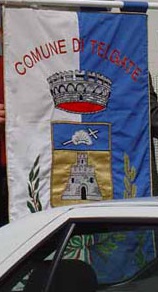 image located by Ivan Sache,
31 December 2012
image located by Ivan Sache,
31 December 2012from http://www.smartno-litija.si

Last modified: 2013-01-20 by rob raeside
Keywords: telgate | bergamo | lombardy |
Links: FOTW homepage |
search |
disclaimer and copyright |
write us |
mirrors
 image located by Ivan Sache,
31 December 2012
image located by Ivan Sache,
31 December 2012
from
http://www.smartno-litija.si
See also:
The municipality of Telgate ( in Bergamo dialect, Telgàt; 4,932 inhabitants;
812 ha) is located in the east of the Bergamo Province. Telgate was mentioned
for the first time in 830, via its baptismal church. However, a coaching inn
probably existed there on the Roman times, serving the Brescia-Milan road. The
parish church of Telgate was indeed involved in several historical events. In
1156, the municipal militia from Bergamo and Brescia, who had fought in the
bloody Battle of Grumore, signed a truce in the St. Michael church, long
disappeared. The truce was quickly broken, until a new treaty signed in 1198,
again in Telgate but in the St. Peter church, eventually settled the dispute. At
the time, Telgate was ruled by the Valvassori family, who set up its court in
the local castle. The Valvassori are the ancestors of the famous Valvasor
Slovene family, thus explaining the partnership between Telgate and
martno pri Litiji, the cradle of the Slovene branch.
They were succeeded in 1387 by the Marenzi. The very rich and powerful lords of
several places around Bergamo, the Marenzi revamped Telgate's fortifications and
transformed the old castle into a cosy manor. In 1440, they were made Counts of
Telgate and Tagliuno by Duke of Milan Philip Mary Visconti (1412-1447). In the
late 15th century, Telgate was ran by the Republic of Venice, which boosted its
development due to its location between Brescia and Bergamo. In 1797, Telgate
was incorporated to the municipality of Grumello del Monte by the administration
of the Cisalpine Republic, created by Napoléon Bonaparte. Subsequently
incorporated to the Kingdom of Lombardy-Venetia, Telgate regained its municipal
independence but trade was diverted to Valcalepio, making of Telgate a small
rural town. Telgate regained some significance in the 20th century with
industrialization and the building of the A4 highway that crosses the municipal
territory.
http://www.comune.telgate.bg.it/sito/index.php?option=com_content&view=article&id=60
- Municipal website
The flag of Telgate, hoisted vertically, is
vertically divided white-blue with the greater municipal arms in the middle.
"COMUNE DI TELGATE" is written in yellow letters forming an arch above the arms.
The flag can be seen on photos taken during friendly meetings with the Slovene
partner town of Telgate, martno pri Litiji.
http://www.smartno-litija.si/en/image-galleries/smartno-delegation-in-telgate-16-18-sept-2005
- Telgate (town hall), 16-18 September 2005
http://www.smartno-litija.si/en/image-galleries/first-italian-delegation-official-visit
- martno pri Litiji, 2 July 2005 - here the writing seems to be dark orange or
red
http://www.smartno-litija.si/en/image-galleries/j-v-valvasor-united-smartno-pri-litiji-and-telgate-m
- martno pri Litiji, 27 May 2006
The flag hoisted over the town hall
seem to be horizontal, vertically divided white-blue with the greater municipal
arms in the middle. Whether the writing appears on this flag or not cannot be
seen on the source photo.
http://www.ecodibergamo.it/stories/Cronaca/255099_la_discarica_non_sha_da_fare_mozioni_a_telgate_e_palosco
- "L'Eco di Bergamo", 16 December 2011
The arms of Telgate are "Or a
castle azure port and windows sable a chief azure a scallop argent over a cross
of the same per bend sinister." The shield is surmounted by a mural crown argent
field gules and surrounded by branches of olive (?) proper tied per saltire
under the shield with a ribbon of the Italian colors. The arms of Telgate were
designed in 1964 by the local historian and heraldist Renato Verdine, from
Bergamo, as a "synthesis of the historical, religious and civil elements"
representing the town, mostly the baptismal church and the castle. The arms are
seemingly based on an "old" coat of arms showing the same elements, unless the
today's arms are a modernization of Verdine's original design (the source text
is not clear on this). In chief, the white scallop placed over the cross set up
diagonally is not a simple decorative attribute but recalls that the Telgate
church was the oldest baptismal church in the diocese, exerting its jurisdiction
over a large territory. The castle, represented with Ghibelline crenellation,
recalls the old urban and strategic structure of the town, then surrounded by a
wall protected by several fortified towers.
http://www.comune.telgate.bg.it/sito/index.php?option=com_content&view=article&id=101
Ivan Sache, 31 December 2011